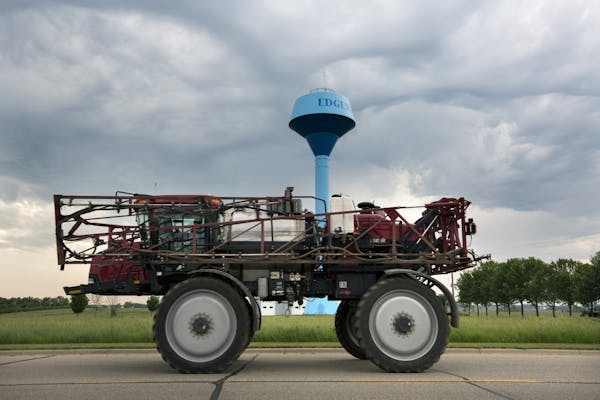Adeline Banttari has been drinking water from her well ever since she and her husband built their home in Cottage Grove 36 years ago.
But now, at 84 and thinking maybe it's time to sell, Banittari has discovered there's a problem. Her water is contaminated with fertilizer from the farm fields across the road, where agriculture butts up against the east side of the Twin Cities metropolitan area. And she can't sell a house with contaminated drinking water.
"I'd like to connect to city water," she said. "But how much will that cost?"
Groundwater tainted with farm chemicals is not just a rural problem, as Bantarri and her neighbors across Washington and Dakota counties are discovering.
In the past two years, the biggest home well-testing program ever conducted by the state of Minnesota has found that in some parts of the two counties, a startling one-fifth to one-half of private drinking wells have nitrate concentrations that are unsafe for infants, children and pregnant women.
And as the test results roll in, what was often an invisible health threat is becoming an expensive headache for hundreds of suburban homeowners.
Connecting with the Cottage Grove water system, for example, would cost Bantarri thousands of dollars — even if it were feasible. And an in-home water purification system can cost hundreds of dollars per year.
Or, as many homeowners do, they can take the risk and do nothing.
"We take our water so much for granted," said Mick Ramey, a real estate agent who has worked in Washington County for years, and who recently found out that his own well water is not safe for his pregnant daughter.
Ramey is urging his neighbors and clients to test their wells before putting their homes on the market, and to solve the problem if test results come back high. Otherwise, he said, just like a home with high radon or a leaky roof, it's quite possible that "the lender will not seal the deal."
'Blue-baby' syndrome
The state well-testing program is part of a long-term research project by the Minnesota Department of Agriculture to figure out how farming affects the drinking water of the 1.2 million Minnesotans who rely on private wells. Some 70,000 wells will be tested in coming years in areas known to be at high risk — in a band of eight counties that stretches northwest roughly from Rochester to Wadena.
Homeowners in Dakota and Washington counties are among the first. Farming has long been an economic bedrock in both counties. But beneath the black dirt on the surface lies a porous layer — gravel and sandy soils left behind by glaciers — that allows water carrying nitrates from fertilizer to percolate swiftly down to the groundwater, where it eventually finds its way to private and municipal wells.
At high levels, nitrates are a serious threat to infants and children. The nitrates interfere with oxygen in the blood, causing what is commonly known as "blue-baby syndrome," which is potentially lethal. It can cause other health problems at lower levels.
Since new well construction and testing rules took effect in 1975, such cases have become increasingly rare, said Chris Elvrum, manager of the state Health Department's well program. The last known blue-baby case in Minnesota occurred in 1980, though they have occurred more recently elsewhere. Numerous studies have also linked high nitrates to cancer in both adults and children, but the U.S. Environmental Protection Agency says the evidence is insufficient to support tougher standards.
Still, as nitrogen-loving corn has taken over Minnesota's rural landscape, nitrate levels in groundwater are rising. Sixteen communities have municipal water found to violate the state health limit for nitrates, and half have installed expensive nitrate-removal systems at a cost per household of $3,300 or more. And more than 45 other communities across the state are trying to slow nitrate contamination before they have to install expensive removal systems.
One-fifth test high
In Dakota County, the city of Hastings has installed a multimillion-dollar reverse osmosis system. State and county health officials have long urged homeowners to get their water tested as well. The county is a state leader in land conservation, and in working with farmers to reduce fertilizer use.
But now, with the latest round of well testing, health officials have realized that the contamination is much worse than they knew.
"Some areas that are really high, that's surprising to us," said Kim Kaiser, a hydrologist with the Minnesota Department of Agriculture who is managing the project. "But we are looking there for a reason."
On average across the county, one-fifth of private wells have nitrates exceeding the federal health limit of ten parts per million, said Jill Trescott, the county's groundwater protection supervisor. But that varies widely — in Marshan Township near Hastings, more than half of the wells have excessive levels.
"That's a lot of wells," she said.
It's up to homeowners to decide what to do. Federal law requires municipal water systems to meet legal standards, but not private wells.
So far in Dakota County, only 28 percent of homeowners with contaminated wells have installed in-home reverse osmosis treatment systems, which cost $300 to $400 per year to operate. It's not clear how many buy bottled water, find other sources — or just drink the water.
Tim Figge, a Dakota County resident, installed a reverse-osmosis system in his house three years ago when his daughter became pregnant. Ever since, he's spoken out at public meetings about irrigation and other farming practices and county officials who, he says, aren't doing enough to protect the water.
"The damage done to the aquifer is so significant it could kill little kids," he said. "That's speaking as a grandpa."
His reverse-osmosis system is not a perfect fix, he said. "It makes everything taste like straw," he observed. It also wastes two gallons of water for every clean gallon it produces.
For those reasons, plus the cost, "reverse osmosis not used on a large scale," Trescott said.
Subsidize homeowners?
County officials, who say the problem is ubiquitous and deeply entangled in the agricultural economy, are now taking the unprecedented step of asking the state for help.
Next year, the county commissioners plan to ask the Legislature for public assistance to homeowners who want to install reverse osmosis systems. For Dakota County that would cost more than $500,000 per year, said Trescott. As well test results from other counties roll in, the cost is only likely to grow.
"It's an issue, not just for Dakota County, but of statewide significance," said Mike Slavik, a Dakota County Commissioner.
In a parallel effort, local environmental officials are taking the longer view and working with farmers like Tim Behrends to change farming practices. For Behrends, a third-generation Washington County farmer, it's an old story.
"This was a cow yard out here," he said, waving out the door of his barn toward the green sweep of his cornfields. "That was pigs over there. There was a lot of manure."
The wells on his family's farms, he said, have always been high in nitrates. When his kids were little, his wife drove into town to get cooking and drinking water from her mother, he said. Years ago he put a reverse osmosis system in their current house.
But on this perfect summer day Wendy Griffin, natural resource specialist for the Washington Conservation District, was visiting to talk about a different solution. Behrends is going to experiment with planting cover crops this fall — an old idea that's come back into vogue. In Behrend's grandfather's day, cover crops like rye were planted between crops to hold the soil in place. These days they are appealing because the take up nitrogen fertilizer left behind after harvest.
"We noticed that nitrates were increasing from year to year," Griffin said.
It's one of many solutions that Griffin and other conservationists across the state are teaching — and some farmers are adopting — to solve a problem that's been decades in the making. Others include buffer strips along waterways and forgoing fertilizer applications in the fall.
For modern-day farmers, planting cover crops means more expense and more work, but Behrends said he's willing to try it because he's getting financial support from a federal program.
If it works, he added, "maybe I can figure out a way to do it without much expense."
Josephine Marcotty • 612-673-7394

'Safe recovery sites' would offer syringes, naloxone and more to people using drugs. The plan could be in peril.
New Minnesota GOP leaders seek peace with party's anti-establishment wing

Who is Republican Lisa Demuth, Minnesota's first House speaker of color?

